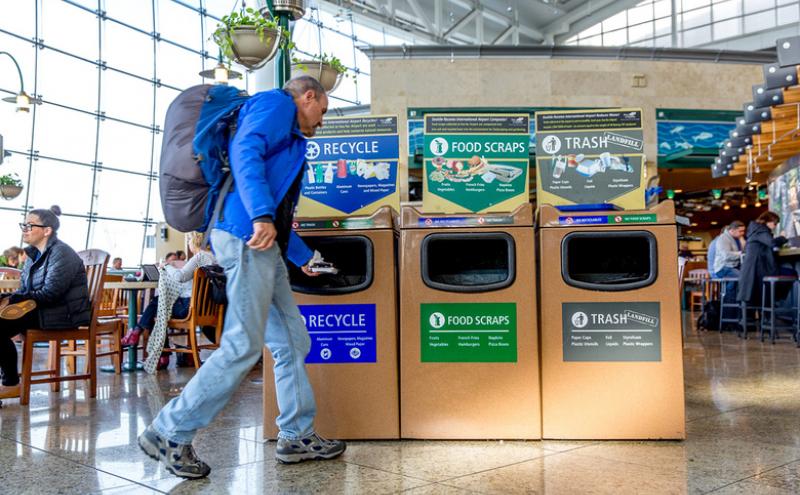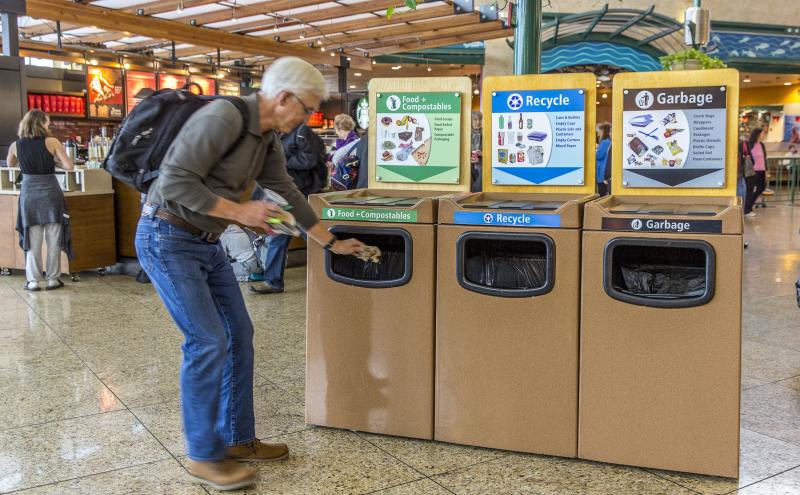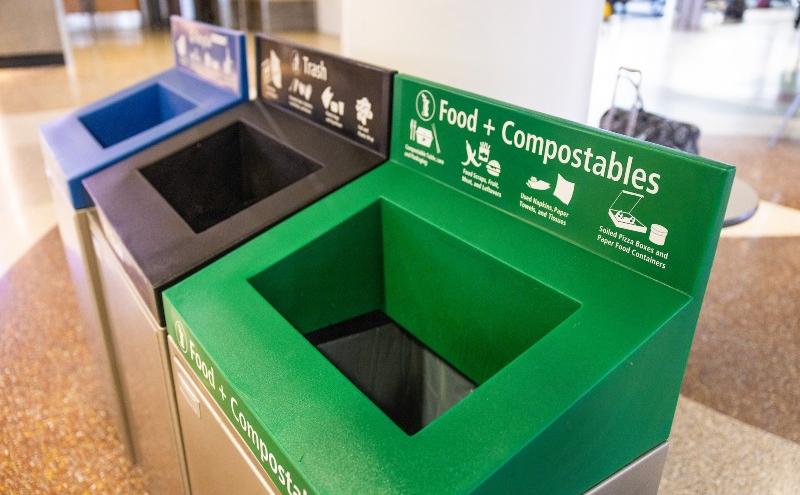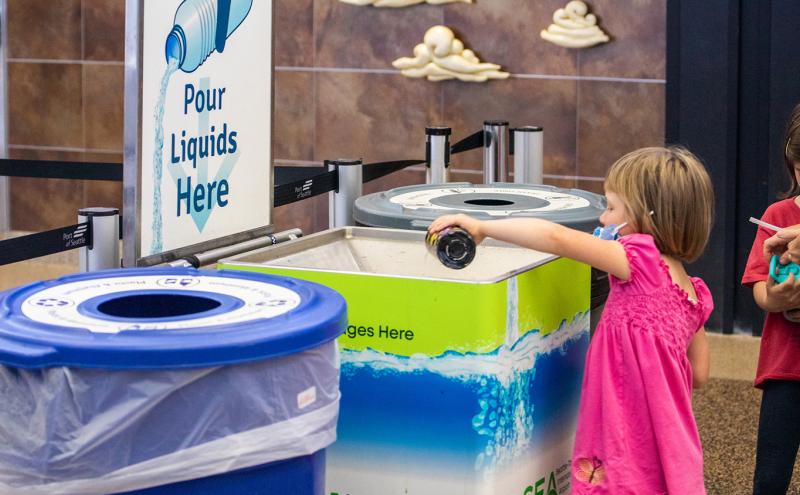
By Jaden Keatts, Port Waste Reduction and Outreach Support Intern
I bet the last thing that you think about before taking off on vacation from Seattle-Tacoma International Airport (SEA) is trash. It’s an important, but often invisible, challenge for facilities.
Did you know that every airport passenger generates nearly half a pound of waste every airport visit? In 2019, the airport processed around 10,000 tons of municipal solid waste and about 8,000 tons in 2021 during the pandemic. With passenger numbers back to pre-pandemic levels, the amount of waste is increasing too. Where does all that trash go?
I am currently in my third year of college at the University of Washington, where I am double majoring in Communication and Education; Communities and Organizations; with a minor in Environmental Studies. I’m the Port’s Waste Reduction and Outreach Support Intern and can tell you with authority that I know about trash at SEA Airport. This internship has been a fantastic opportunity to explore the intersection between my academic subjects.
During my internship, I visited every area of SEA Airport to inventory the public waste receptacle bins, updated recycling educational information on the Port’s website, surveyed passengers on their opinions about sustainable beverage packaging, and participated in many other projects.
I know a lot about the innovative strategies SEA implements to recycle more materials and prevent their generation in the first place. All to support the Port’s Century Agenda goal to “be the greenest and most energy-efficient port in North America.”
Here are seven facts about waste reduction and recycling at SEA:
1. There are more than 500 waste receptacle bins at SEA Airport
I know because I counted them all! You’re conscientious about properly sorting your waste at home, and you can do the same at the airport, thanks to the substantial number of public area bins. You can find recycling, food + compostables, and trash bins throughout the airport. Bins are everywhere, from gate hold areas to the top level of the parking garage. As a traveler, you play a key role in the success of waste diversion, which is why there are so many conveniently located bins for you.
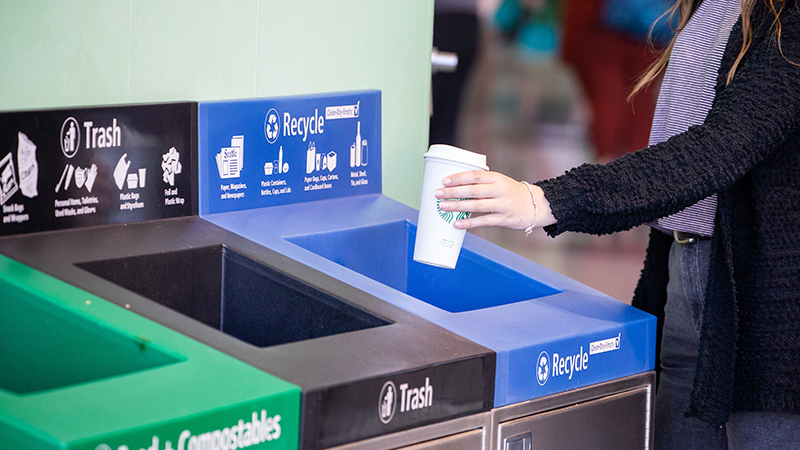
Since 2019, SEA has added 88 recycling bins and 21 food + compostables bins in public areas. These numbers will continue to increase, giving you more opportunities to properly sort your waste!
2. Liquids doom recyclable materials to a life in the landfill
Liquids contaminate recyclables and send otherwise recyclable materials to the landfill. To help remove liquid from the recycling stream, SEA Airport just installed 12 more liquid collection bins after security in high traffic areas. This is one example of a pilot project I worked on as an intern!
These bins function like the liquid drain stations at every Security Checkpoint. Enjoy your beverage, pour out any excess liquid down the bin’s drain, and recycle or dispose of your beverage container. Find recycling receptacles next to every liquid collection bin. Making sure your items are empty, clean, and dry helps SEA recycle more materials.
3. Your recycling efforts kept the equivalent of 97 solid waste trucks of compost and nine Boeing 747s of recycling out of the landfill
The airport composts around 1,300 tons and recycles around 1,700 tons annually* of waste from travelers and tenants (restaurants and stores) in the terminal area. Great job on diverting materials from the landfill!
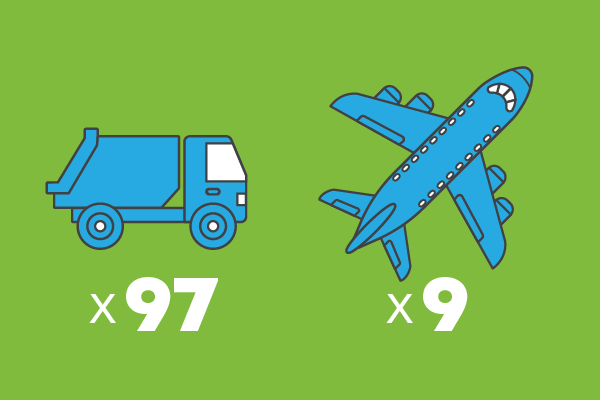
In 2021, SEA diverted 41% of the waste generated in the terminal. You can help support the goal of diverting 60% of waste by continuing to properly sort. The stickers on the bins were specifically designed to help you quickly identify what goes where.
Have a question about where a material goes? Visit the Passenger Recycling Information page.
*Based on tonnage data from March 2019 through February 2020
4. Composted materials return to the airport as soil amendments for landscaping
Materials in the airport’s food + compostables bins go to Cedar Grove, a local composting facility in Maple Valley, Washington. Here they are turned into compost which enriches soil and promotes plant growth. The Port purchases this compost and uses it in airport landscaping and construction projects.
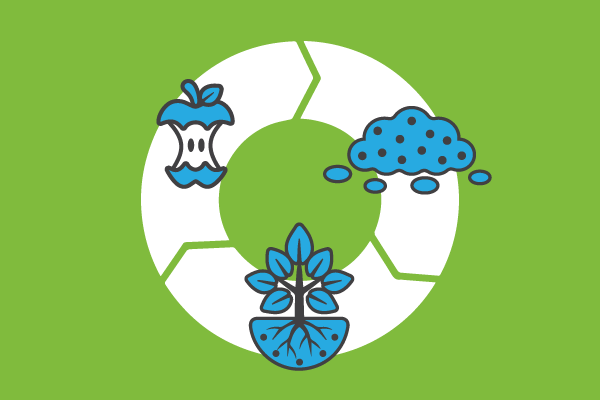
5. You are an essential part of reducing waste at the airport
While it’s great for composted materials to return to the airport as something new, we can all help prevent waste in the first place.
Here’s how you, as a traveler, can help:
- Bring your reusable water bottle. Remember that you need to bring it through security empty; you can easily drain them at the liquid drain stations. Then fill it after security at one of the 20 water bottle refill stations. Search for water fill stations on the interactive map
- Opt for reusable products when dining or bring your own reusable food service ware. Reusable products go through the dishwasher, making them clean and ready for another traveler to use. Disposable food service ware can only be used once, but reusables can be used over and over again
- Use digital boarding passes. Go paperless by accessing your boarding pass on a mobile device and you’ll be ready to fly. Digital passes remove the worry about misplacing or losing a print copy
Because the best way to protect the environment is to prevent waste in the first place, SEA Airport is focusing on increasing the use of reusables by both travelers and tenants. Airport tenants play a big role in waste reduction; they’re also encouraged to use reusable items over disposable ones. Recently, I helped create a set of stickers for reusable food service ware collection bins and a poster to remind airport employees to use reusable items over disposables. These materials and other educational materials are provided for free to airport tenants to encourage their teams to join the movement!
6. Used cooking oil from SEA Airport restaurants turns into biodiesel, a renewable fuel
Like passengers, tenants sort their waste into recycling, food + compostables, and trash bins. Along with traditionally accepted recyclable materials, tenants also recycle used cooking oil and scrap metal. In 2021, SEA recycled around 12,000 gallons of used cooking oil and nearly 70 tons of scrap metal through local vendors.
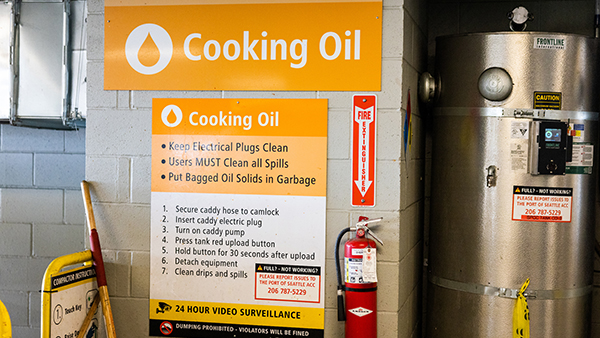
7. SEA Concessionaires have donated more than two blue whales’ worth of food to our neighbors in need
Airport Concessionaires and tenants who generate food can participate in the Food Donation Program, a partnership with the Des Moines Area Food Bank. Participating in the program prevents safe and edible food that does not get purchased from going to waste. As of 2021, a total of 510,678 pounds of food have been donated and diverted from SEA’s waste stream. That’s more than the weight of two blue whales!
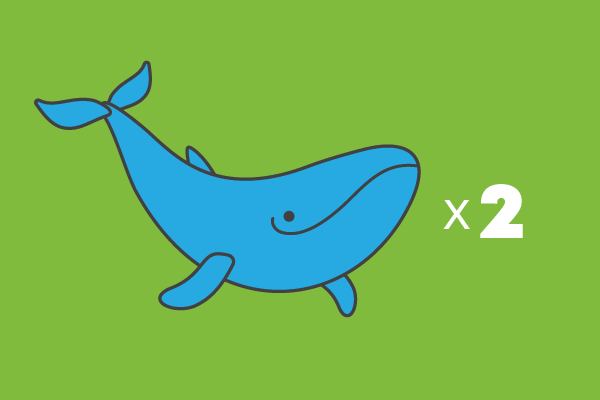
SEA Airport is always looking for new ways to further reduce its impact. Continue to do your part by using reusables and properly sorting your waste!

